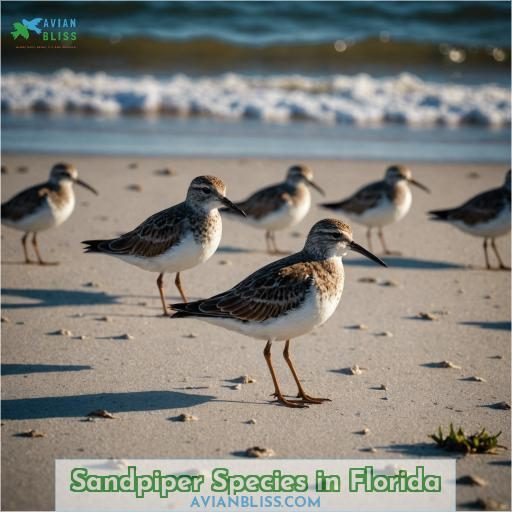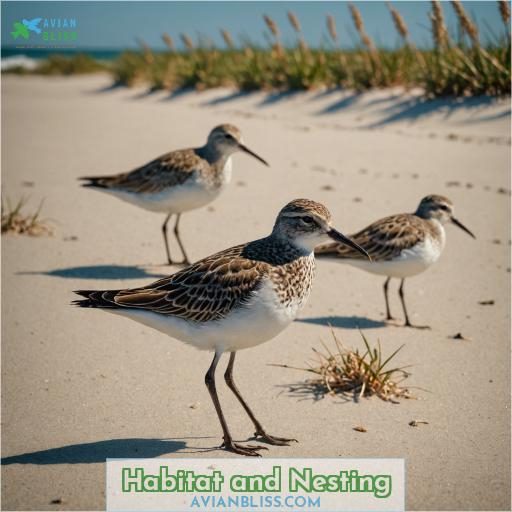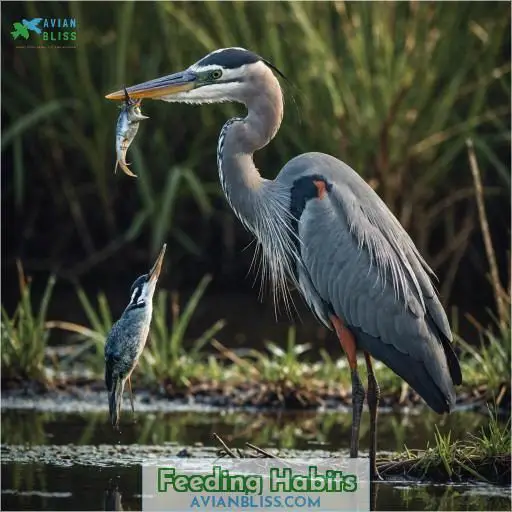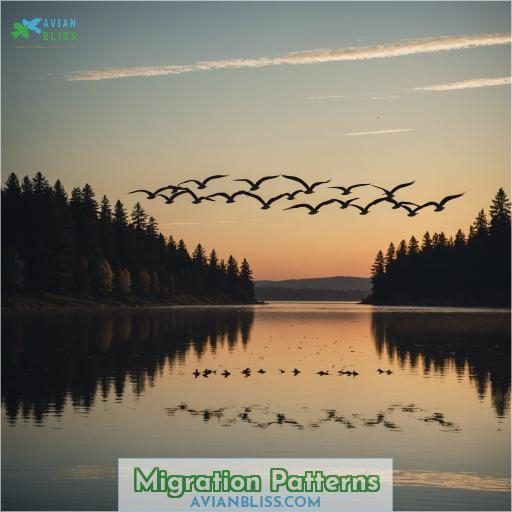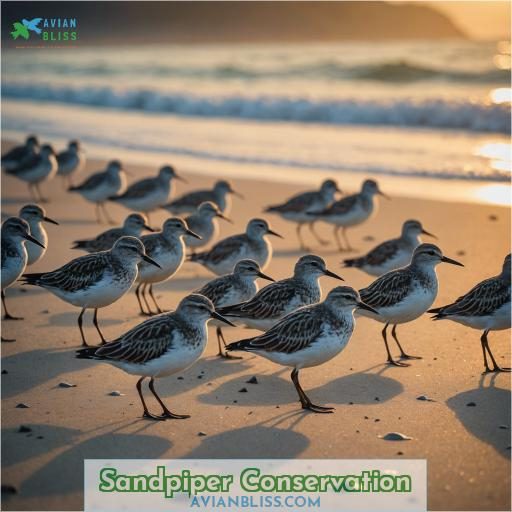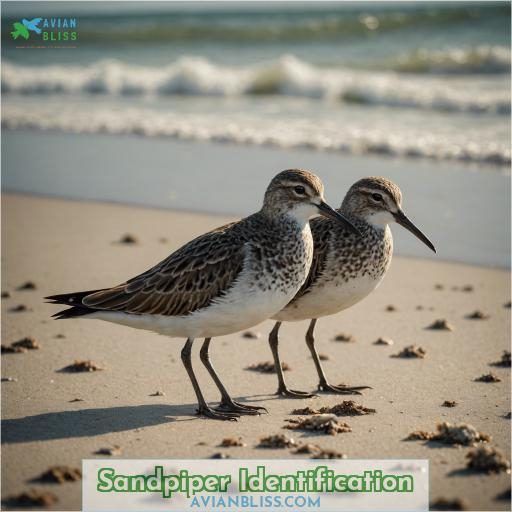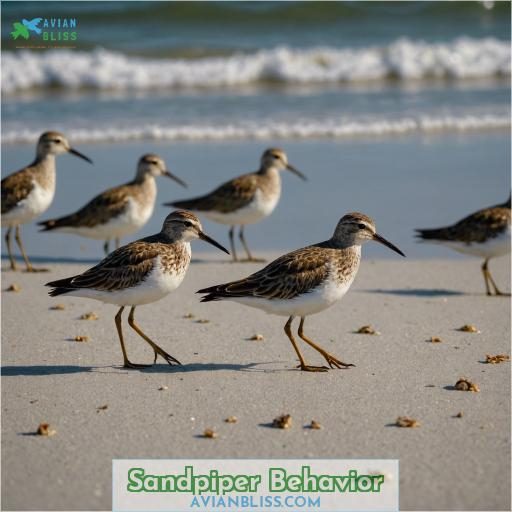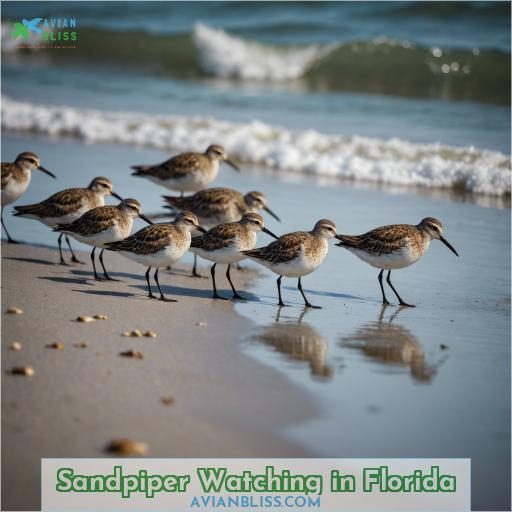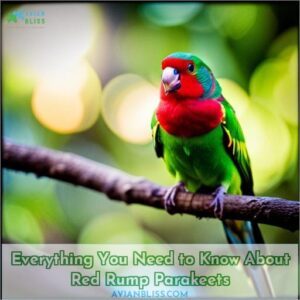This site is supported by our readers. We may earn a commission, at no cost to you, if you purchase through links.
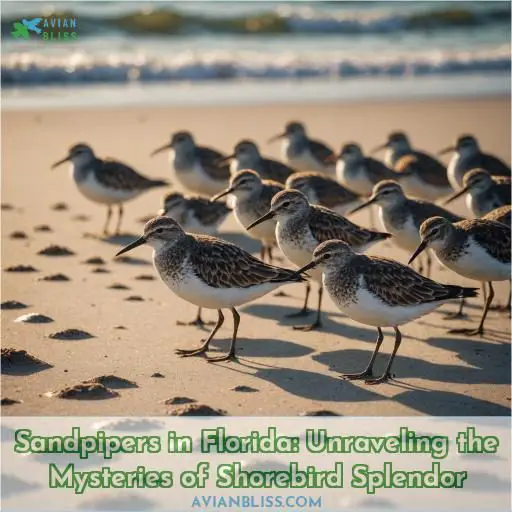 When exploring Florida’s coastlines, you’ll encounter a diverse array of sandpipers. These shorebirds exhibit striking plumage hues like earthy browns and rufous tones, complemented by slender, curved beaks adapted for probing the sand.
When exploring Florida’s coastlines, you’ll encounter a diverse array of sandpipers. These shorebirds exhibit striking plumage hues like earthy browns and rufous tones, complemented by slender, curved beaks adapted for probing the sand.
From petite Sanderlings to statuesque Willets, sandpipers in Florida range in size and weight. Many species breed in the Arctic tundra before migrating to Florida’s beaches for the winter.
Preserving nesting sites and minimizing human disturbance are vital conservation efforts. By learning their unique behaviors and identification cues, you’ll gain a deeper appreciation for these remarkable avian migrants.
Table Of Contents
- Key Takeaways
- Sandpiper Species in Florida
- Physical Characteristics
- Habitat and Nesting
- Feeding Habits
- Migration Patterns
- Sandpiper Conservation
- Sandpiper Identification
- Sandpiper Behavior
- Sandpiper Watching in Florida
- Sandpiper Photography
- Frequently Asked Questions (FAQs)
- What does a Florida sandpiper look like?
- What are the little birds on the beach in Florida?
- Do sandpipers live in Florida?
- What is the difference between a spotted sandpiper and a common sandpiper?
- Are sandpipers aggressive towards humans on the beach?
- Can sandpipers be kept as pets in Florida?
- Do sandpipers make good alarm systems for beachfront homes?
- How long do sandpipers live in the wild?
- Can sandpipers be hunted for food in Florida?
- Conclusion
Key Takeaways
- Sandpipers in Florida exhibit a diverse array of plumage colors, beak shapes, and size variations, adapted for their specialized feeding and nesting behaviors.
- Many sandpiper species in Florida undertake remarkable long-distance migrations, breeding in the Arctic tundra before wintering along the state’s coastlines.
- Conservation efforts are crucial to protect threatened sandpiper species, such as the Snowy Plover and Piping Plover, from habitat loss and human disturbance.
- Observing sandpipers in Florida requires ethical birding practices, including respecting nesting areas and minimizing disturbance, to ensure the sustainability of these remarkable shorebirds.
Sandpiper Species in Florida
You’re a curious beachgoer, aren’t you?
As you stroll along Florida’s sandy shores, those little shorebirds scurrying ahead of the waves pique your interest.
Let me enlighten you about our remarkable sandpipers!
These avian wonders boast a rich taxonomy, from the petite sanderlings to the striking dowitchers.
Evolved for migration, they undertake epic journeys along ancient flyways.
Some nest right here on our beaches.
But many face conservation challenges, prompting efforts to protect their fragile habitats.
Embrace your fascination – sandpipers offer a gateway to understanding nature’s delicate balance.
Physical Characteristics
Sandpipers showcase an array of plumage colors, ranging from the subdued browns and grays that provide camouflage on coastal sands to the striking rufous hues that adorn their breeding attire.
Their beaks are finely adapted tools for probing and pecking. They come in various shapes—from the slender, curved bills of Willets to the short, sturdy upturned beaks of Ruddy Turnstones designed for flipping over shells and debris in search of prey.
Plumage Colors
You’ll marvel at sandpipers’ plumage variation, from earthy tones camouflaging nests to striking breeding colors separating sexes. Seasonal changes create kaleidoscopic beauty across Florida’s shores.
Beak Shapes
As you observe sandpipers, note their beaks’ shapes:
- Thin, needle-like bills for probing mud
- Upturned tips for flipping seaweed
- Sturdy, pointed beaks for cracking shells
- Long, curved bills for deep probing
These specialized bill shapes reveal sandpipers’ diverse feeding techniques.
Size Variations
From the petite Sanderling to the statuesque Willet, sandpipers showcase remarkable size variations. Their weights span ounces to pounds, dictated by growth patterns, sexual dimorphism, and age-related changes. Appreciating this diversity enriches any shorebird enthusiast‘s experience.
Habitat and Nesting
Sandpipers in Florida thrive along the state’s extensive beaches and coastal habitats, where they find prime nesting grounds. During the nesting season, these remarkable shorebirds exhibit a range of fascinating behaviors, from intricate courtship displays to precise nest construction and protection.
Beach and Coastal Habitats
You’ll find sandpipers on:
- Beaches, where their sandy tones camouflage them
- Coastal marshes and mudflats
- Dunes and other shoreline habitats
Their habitats face threats like beach erosion and human development, making protection essential.
Nesting Behaviors
You’ll find sandpipers attentively constructing concealed nests, often mere indentations in sandy areas. Both parents incubate eggs, with precocial chicks departing the nest soon after hatching. Ensuring their fledglings’ survival is a top priority.
Nesting Season
Timing your beach visits during shorebird nesting season allows glimpses of sand-colored camouflaged chicks developing precocially near protective nesting enclosures. Respect these areas’ crucial roles in sustaining species diversity.
Feeding Habits
You’ll witness sandpipers employing an array of ingenious foraging techniques to procure their prey items along Florida’s coastal regions. These shorebirds strategically probe into the sand with their specialized bills, flipping over shells and sifting through decaying matter to extract marine worms, crustaceans, and tiny mollusks that comprise their diet.
Prey Items
You’ll find sandpipers relish small aquatic invertebrates, crustaceans like beach hoppers, and even insects – thanks to beaks adapted for probing shorelines. Their prey preferences range from royal terns plucking fish to ibises and spoonbills scooping for shrimp.
Foraging Techniques
You’ll observe sandpipers employing specialized foraging strategies: leaning forward, probing with bill adaptations suiting their prey preferences and habitat specialization. Conservation challenges remain regarding bird nesting sites and injured birds.
Feeding Behaviors
In addition to their diverse foraging techniques, sandpipers exhibit fascinating feeding behaviors that allow them to exploit their prey efficiently. Here are three key aspects:
- Prey preferences
- Habitat partitioning
- Feeding adaptations
Migration Patterns
Many sandpiper species that visit Florida undertake remarkable long-distance migrations, breeding in the Arctic tundra regions during summer before making arduous journeys to warmer wintering grounds along the state’s coastlines. Understanding the migration patterns, including the specific routes taken and the timing of movements, is essential for effective conservation efforts aimed at protecting these remarkable shorebirds.
Breeding Grounds
As spring arrives, witness sandpipers’ diligence in securing prime breeding territories, engaging in elaborate courtship displays. Observe egg-laying behavior and parental care ensuring chick survival and ample brood sizes through meticulous incubation periods.
Wintering Grounds
You’ll find them in coastal areas, taking advantage of warmer climates. Some stay year-round, molting and building up reserves. Monitor changes in wintering behaviors and populations, as climate change impacts their seasonal movements.
Migration Routes
Their migration patterns follow ancient aerial highways, stopovers carefully timed across continents. You’ll marvel at the sandpipers’ mastery of navigation, orchestrating flights of thousands of miles with pinpoint precision.
Sandpiper Conservation
You’ll find that some sandpiper species in Florida, like the Snowy Plover and Piping Plover, are listed as threatened due to habitat loss and disturbance of their fragile beach nesting areas. To conserve these vulnerable shorebirds, many coastal areas rope off and closely monitor their nesting sites during the breeding season to protect the birds and their young.
Threatened Species
You’ll want to watch for the petite Snowy and Piping Plovers—their populations decline due to human activity. Learn their distinct markings; beach-goers play a role in conservation efforts for these threatened sandpipers.
Habitat Loss
You can’t overlook threats like human-caused habitat loss. Sand mining, oil spills, and pollution degrade coastal areas critical for sandpipers.
Beach Nesting Protection
To protect beach-nesting sandpipers, minimize human disturbance, maintain high-quality sand, and control predators like raccoons. Roping off nesting areas and educating beachgoers are key to ensuring successful sandpiper breeding seasons.]
Sandpiper Identification
You can identify different sandpiper species by their distinctive visual field marks, such as plumage colors, beak shapes, and size variations. Listen carefully for their unique calls and vocalizations, and observe their characteristic flight patterns, which can aid in pinpointing the species.
Visual Field Marks
With sandpiper conservation efforts underway, identifying species through visual field marks is paramount. Study plumage variations, beak adaptations, size comparisons, and habitat preferences to unravel these shorebirds’ identities.
Calls and Vocalizations
Sandpipers communicate through a variety of vocalizations, from trills and whistles to piercing alarm calls. Their territorial songs and courtship displays are key to understanding their behavior and identifying different species. Some even mimic other birds.
Flight Patterns
Sandpipers exhibit a variety of distinctive flight patterns. They often fly in tight flocks, performing acrobatic courtship displays with rapid wing beats. Their long, slender wings enable swift, agile flight at speeds up to 40 mph.]
Sandpiper Behavior
When observing sandpipers, you’ll witness fascinating courtship displays as males perform intricate dances and vocalizations to attract potential mates. Their social behaviors include forming loose flocks during migration and winter, engaging in squabbles over prime feeding spots, and collaborating to drive away predators through synchronized distraction displays.
Courtship Displays
You’ll be awed by sandpipers’ courtship rituals—aerial acrobatics, wing-trills, synchronized dances. Witness them staking territorial claims, pair bonding through synchronized foraging, and adeptly securing prime nesting spots.
Social Behavior
You’ll observe sandpipers exhibiting social dynamics, from territorial squabbles to coordinated flocking. They communicate through vocalizations and displays, jostling for position and resources.
Predator Avoidance
You’ll see sandpipers use:
- Camouflage tactics to blend with surroundings
- Group foraging to spot predators sooner
- Vocal communication to warn of nearby threats
These adaptations help them avoid predators effectively.
Sandpiper Watching in Florida
To witness the enchanting world of sandpipers in Florida, you’ll want to visit prime shorebird habitats during the most favorable viewing periods. When birding, it’s vital to follow ethical practices that prioritize the well-being of these remarkable avian species and their sensitive coastal environments.
Best Locations
From St. Joseph Peninsula to Boca Grande Key, you’ll find prime sandpiper spots where coastal conservation efforts protect endangered species’ nesting grounds despite beach erosion and urban development threats intensified by climate change.
Prime Viewing Times
The best times to spot sandpipers in Florida are during spring and fall migrations, when they congregate in large numbers to feed and rest. Look for them at:
- Coastal wetlands and beaches
- Mudflats and sandbars
- Freshwater marshes and ponds
- Tidal creeks and estuaries
- Grassy fields and pastures
Ethical Birding Practices
When birdwatching, always respect the birds and their habitats. Avoid disturbing nesting areas, keep your distance, and follow local regulations to guarantee a sustainable future for Florida’s shorebirds. Ethical birding supports responsible tourism and wildlife conservation.
Sandpiper Photography
To capture the intricate beauty and behavior of Florida’s sandpipers through photography, you’ll need the right equipment.
A DSLR camera with a telephoto lens (ideally 400mm or higher).
A sturdy tripod to steady your shots.
Mastering techniques like low angles.
Fast shutter speeds to freeze motion.
Properly exposing for the bright beach environment.
Will guarantee you create stunning images that showcase the elegance of these shorebirds.
Camera Equipment
When photographing sandpipers, a telephoto lens of 400mm or more is ideal to capture their intricate behaviors, nesting habitats, and feeding techniques during migration. Camouflage clothing and a low shooting position can help you blend in with their natural surroundings.]
Photography Techniques
Capture sandpipers’ camouflage and specialized beaks in action as they forage. Shoot from a distance to avoid disturbing their breeding territories. Employ patience and stealth to document their unique feeding strategies while supporting habitat conservation.
Ethical Photography Guidelines
When photographing sandpipers, maintain a respectful distance to avoid disturbing their natural behaviors. Avoid approaching nesting sites, and be mindful of your presence to protect these shorebirds and their sensitive habitats. Ethical approaches foster sandpiper awareness and habitat preservation.
Frequently Asked Questions (FAQs)
What does a Florida sandpiper look like?
Oh, you thought sandpipers were drab? Their plump bodies sport intricate gray-brown camouflage above, a crisp white underside, and pointy bills for probing sand.
What are the little birds on the beach in Florida?
Those little birds scurrying on the beach are likely sanderlings or willets—shorebirds perfectly adapted to life by the sea. Their slender probing bills let them feast on tiny crustaceans hidden in the sand.
Do sandpipers live in Florida?
Yes, sandpipers thrive in Florida’s coastal habitats. You’ll encounter several species scurrying along beaches and tidal flats, probing for small crustaceans and marine worms with their slender, sensitive bills.
What is the difference between a spotted sandpiper and a common sandpiper?
As they say, A picture is worth a thousand words. The Spotted Sandpiper has distinct spots on its underside, while the Common Sandpiper lacks these markings. This key visual distinction separates these two shorebird species.
Are sandpipers aggressive towards humans on the beach?
Most sandpipers aren’t aggressive toward humans on beaches. They may approach you curiously but usually keep their distance, scurrying away if you get too close to their feeding or nesting areas.
Can sandpipers be kept as pets in Florida?
Around 95% of sandpipers are migratory, making captivity impractical. You’d do better appreciating their freedom on coastal trails. Let them thrive in the wild as nature intended.
Do sandpipers make good alarm systems for beachfront homes?
No, sandpipers wouldn’t make effective alarm systems. Their natural behaviors, like foraging and resting, aren’t suited for alerting you to potential intruders consistently. You’d be better off investing in a proper home security system designed for that purpose.
How long do sandpipers live in the wild?
The tiny Sanderling, running 60 miles in its first week, often lives 6-10 years—an impressive lifespan for its fleeting size. These energetic shorebirds exemplify nature’s resilience.
Can sandpipers be hunted for food in Florida?
Hunting sandpipers for food is illegal in Florida. These migratory shorebirds are protected under federal law, ensuring you can enjoy watching their lively courtship dances during nesting season.
Conclusion
When the curtain falls on your sandpiper watching adventures in Florida, you’ll have a newfound appreciation for these shorebirds’ remarkable adaptations and behaviors. From their intricate plumage to their specialized feeding techniques, observing sandpipers in Florida reveals nature’s brilliance. Embrace ethical birding practices, and you’ll be rewarded with unforgettable encounters showcasing the beauty of these resilient coastal gems.

